How to Reheat Fajitas
To reheat fajitas perfectly, you've got several effective methods at your disposal. For the best results, use a cast iron skillet over medium heat with a splash of oil or water, heating the ingredients for 3-5 minutes while stirring occasionally. Alternatively, wrap your fajitas in foil and warm them in a 300°F oven for 10-15 minutes, adding a tablespoon of water for moisture. You can also use your microwave with a damp paper towel cover for quick results, though this might sacrifice some crispiness. The air fryer offers another great option, heating at 350°F for 3-5 minutes for excellent texture. Each method has its own specific techniques for maintaining the fajitas' original flavor and juiciness.
This post may contain affiliate links. If you make a purchase through these links, I may earn a commission at no additional cost to you. Additionally, portions of this post may be generated using artificial intelligence (AI) technology. While we strive for accuracy, please be aware that AI-generated content may not always be perfect and should be fact-checked when necessary.
The Spatula Scoops
- Cast iron skillet reheating: Heat on medium with olive oil, adding water if needed to maintain moisture while stirring occasionally.
- Oven method: Wrap in foil, heat at 300°F for 10-15 minutes with water in the baking dish for steam.
- Microwave option: Cover with damp paper towels and heat in 20-30 second intervals for 1-2 minutes total.
- Air fryer technique: Heat at 350°F for 3-5 minutes, arranging in a single layer for crispy results.
- Store components separately in airtight containers and reheat only once for best quality and food safety.
What Makes Perfect Fajitas
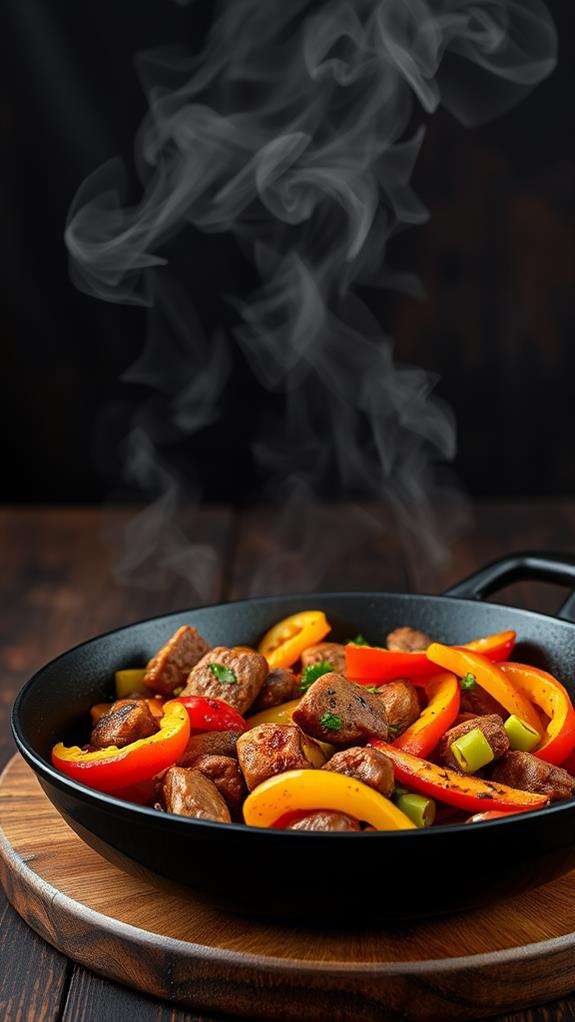
Perfect fajitas start with thoughtful preparation and attention to key details. When you're crafting these sizzling delights, you'll want to begin with proper meat preparation, which includes a vital marinating period of at least 30 minutes, though letting it rest overnight will deliver even better results. You'll find that slicing your meat against the grain isn't just a suggestion—it's essential for achieving that melt-in-your-mouth tenderness you're looking for.
The magic continues with your choice of cooking method and accompanying vegetables. You'll want to heat your cast-iron skillet until it's seriously hot, creating that signature char that gives fajitas their distinctive smoky flavor. As you cook, you'll notice how the combination of colorful bell peppers and onions creates both visual appeal and a perfect balance of sweet and savory notes. Each component plays its part in building layers of flavor, from the perfectly marinated meat to the caramelized vegetables. Don't forget to warm your flour tortillas just before serving—they're the final touch that brings everything together, creating that authentic fajita experience you're aiming for.
Best Reheating Methods
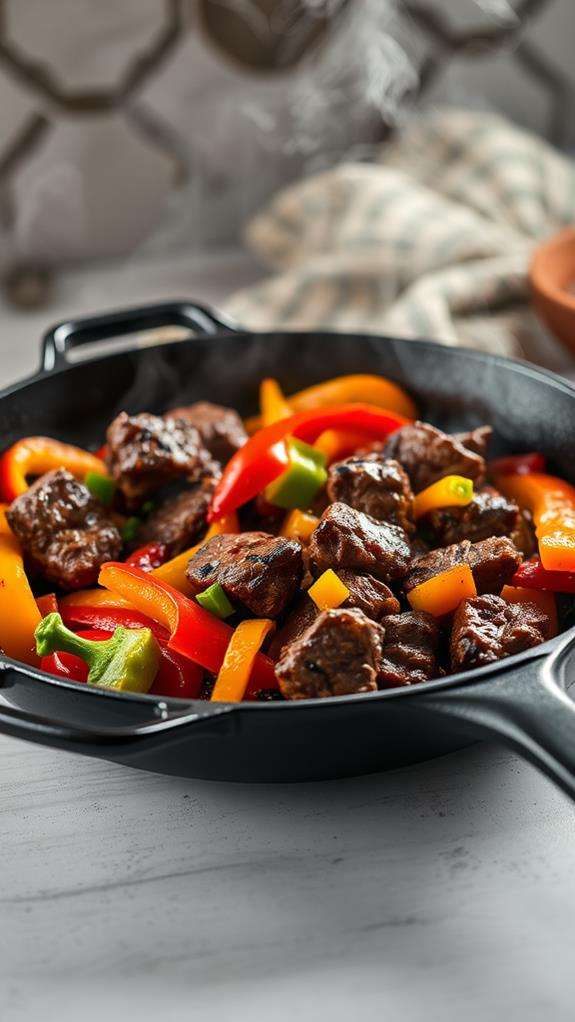
When it comes to bringing leftover fajitas back to life, you've got several reliable methods at your disposal. A cast iron skillet on medium heat offers one of the best approaches, where you'll want to add a splash of olive oil or water to maintain the meat's texture and flavor. Just a few minutes of heating will do the trick.
If you're looking for consistency, your oven provides excellent results. Simply wrap your fajitas in aluminum foil and heat them at 300°F for 10-15 minutes. This method helps prevent moisture loss while ensuring even heating. For a quicker option, you can use your microwave by covering the fajitas with a damp paper towel and heating in short 20-30 second intervals, though you might sacrifice some crispiness.
Your air fryer can also deliver impressive results at 350°F. Place your fajitas in a single layer, give them a light spray of cooking oil if desired, and heat for 3-5 minutes. Remember, regardless of which method you choose, you'll want to reheat your fajitas only once to maintain food safety and preserve their quality.
The Skillet Technique
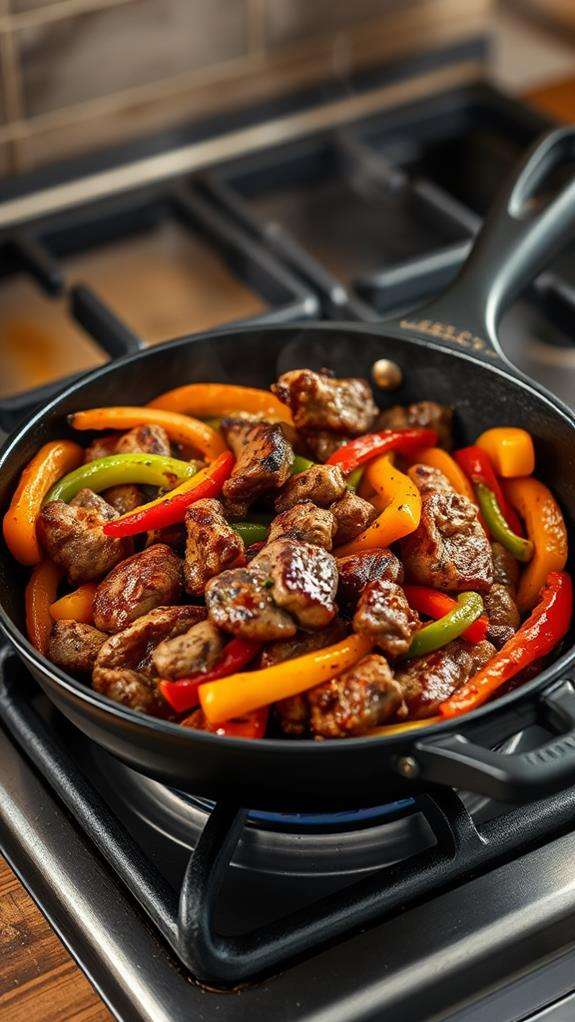
Mastery of the skillet technique gives you ideal control over reheating your leftover fajitas. A cast iron skillet proves particularly effective, as it distributes heat evenly and maintains consistent temperature throughout the reheating process. You'll want to start by heating your skillet over medium to high heat, guaranteeing it's properly preheated before adding any ingredients.
Begin by adding a light coating of olive oil to your heated skillet, then introduce your onions and bell peppers. These vegetables will help recreate that authentic fajita experience while preventing your ingredients from sticking to the cooking surface. As you cook, you'll want to flip the vegetables occasionally to guarantee even heating. When they're nearly done, it's time to add your pre-cooked fajita meat to the mix. To prevent your meat from drying out, consider adding a small splash of water or lime juice to the skillet. This addition creates a slight steam effect that helps maintain moisture while reheating. Continue cooking for just a few minutes more, stirring occasionally until everything's heated through and ready to serve.
Oven Reheating Guide
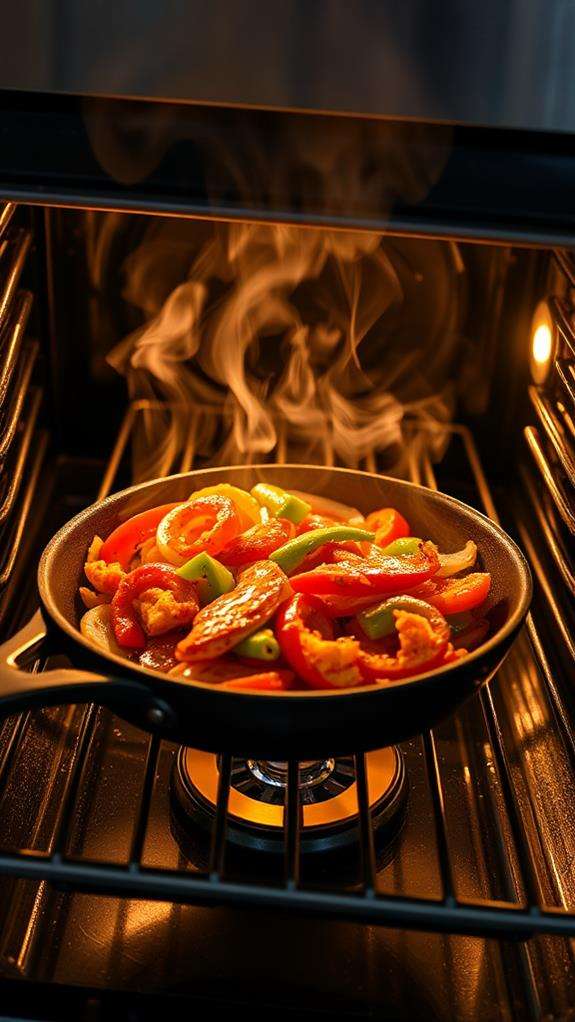
To achieve perfectly reheated fajitas in your oven, you'll want to preheat to 300°F (150°C) and wrap your fajitas tightly in aluminum foil, creating a moisture-sealed package. For the best results, place your wrapped fajitas in a baking dish with a small amount of water at the bottom, which creates a gentle steam environment during heating. Let your fajitas warm through for 10-15 minutes, checking occasionally to confirm they're heated evenly without becoming dry or overcooked.
Temperature and Time Settings
Proper temperature and timing are essential for successfully reheating fajitas in your oven. For ideal results, you'll want to set your oven to 300°F (150°C), which provides the perfect balance between warming your fajitas thoroughly and preventing them from drying out. This moderate temperature setting guarantees you'll maintain the original texture and flavors of your fajitas.
When it comes to precise time settings, aim for 10-15 minutes of heating, but keep these important factors in mind:
- Larger portions may require additional heating time to reach the desired temperature
- Multiple layers of fajitas should be separated onto different baking sheets
- Wrapping in aluminum foil is necessary for maintaining moisture during the heating process
- A small amount of water in the pan helps create steam for juicier results
- Check the internal temperature halfway through to prevent overheating
Remember that these temperature and time settings aren't set in stone – you'll need to adjust based on the quantity of fajitas you're reheating. If you're working with a particularly large batch, consider splitting them between multiple pans to guarantee even heating throughout the reheating process.
Foil Wrapping Techniques
Effective foil wrapping stands as an essential step when reheating fajitas in the oven. To master proper foil wrapping techniques, you'll need to create a sealed package that traps moisture and heat effectively, guaranteeing your fajitas don't dry out during the reheating process.
Start by laying out a sheet of aluminum foil that's large enough to completely enclose your fajitas with extra room for folding. Place your fajitas in the center of the foil, and if you're looking for extra moisture retention, add a tablespoon of water to the bottom of the package. When wrapping, fold the longer sides of the foil upward first, creating a tight seal at the top by crimping the edges together. Then, fold the shorter ends inward with multiple small folds to prevent any steam from escaping. You'll want to guarantee there aren't any gaps or tears in the foil that could let moisture escape. Place your wrapped fajitas on a baking sheet, which helps distribute heat evenly and catches any potential leaks. This careful wrapping method creates a steam-filled environment that'll restore your fajitas to their original texture.
Moisture Control Tips
Success in reheating fajitas hinges on maintaining the perfect moisture balance throughout the process. These moisture control tips will help you achieve restaurant-quality results when warming up your leftover fajitas in the oven.
When you're ready to reheat your fajitas, preheat your oven to 300°F (150°C) and follow these essential moisture-preservation strategies:
- Add 2-3 tablespoons of water or broth to the bottom of your pan, creating a steam environment that'll keep your fajitas tender
- Wrap your fajitas tightly in aluminum foil, guaranteeing there aren't any gaps where moisture could escape
- Cover your baking sheet with an additional layer of foil if you're not using individual foil packets
- Split larger portions between two pans to prevent overcrowding and guarantee consistent moisture distribution
- Check your fajitas after 10 minutes, as overheating can quickly lead to dry, tough meat
Remember to maintain proper spacing between ingredients when reheating, and don't rush the process. By controlling moisture levels through careful wrapping and strategic water addition, you'll preserve the original texture and flavor of your fajitas while guaranteeing they're heated evenly throughout.
Microwave Tips and Tricks
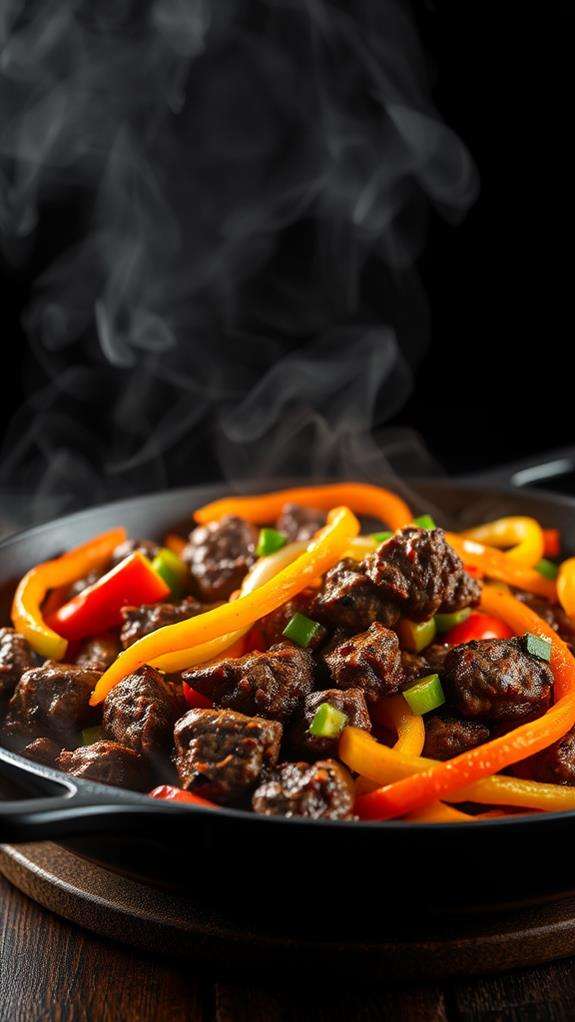
When using your microwave to reheat fajitas, a few key tricks can help maintain their flavor and texture. Start by placing your leftover fajita meat on a microwave-safe plate, and cover it with a damp paper towel, which helps lock in essential moisture during the reheating process.
You'll want to heat your fajitas in short bursts of 20-30 seconds, checking them between intervals to guarantee they're heating evenly. If you notice any cold spots, rearrange the meat and vegetables before continuing. To enhance moisture retention, add a small splash of lime juice or water to the plate before microwaving. This simple step can make a significant difference in preventing your fajitas from becoming dry and tough.
Keep in mind that microwaving typically requires 1-2 minutes total heating time, but you shouldn't heat them continuously. While the microwave offers convenience, it's crucial to recognize that you might sacrifice some crispiness compared to other reheating methods. To maintain the best possible texture, avoid overheating your fajitas, as this can lead to rubbery meat and soggy vegetables.
Using Your Air Fryer
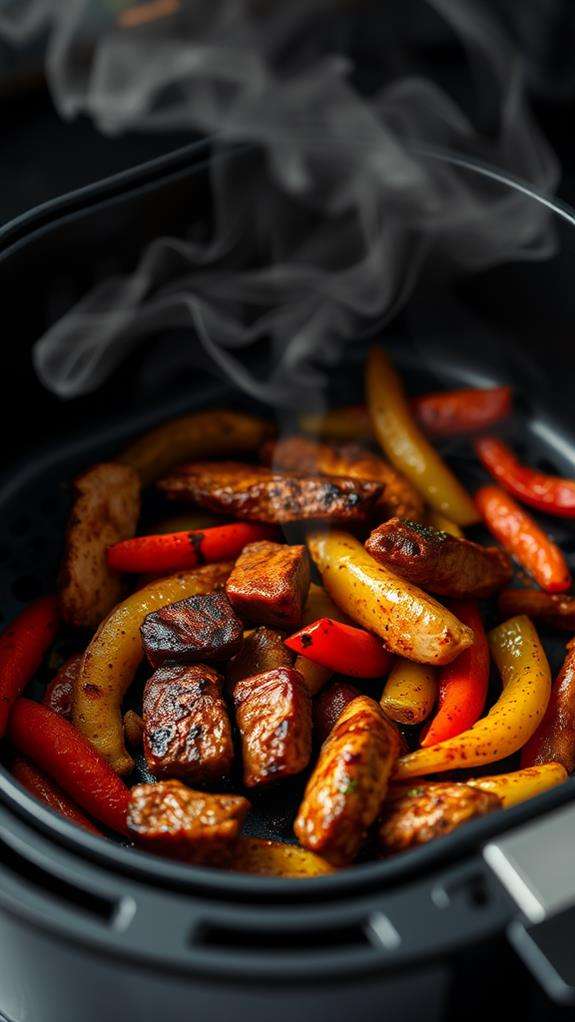
The air fryer stands out as one of the best tools for bringing leftover fajitas back to life, offering both speed and the ability to restore their original crispy texture. To get started, you'll want to preheat your air fryer to 350°F, which creates the perfect environment for reheating your fajitas evenly and thoroughly.
When using your air fryer, remember these essential steps for the best results:
- Place your fajitas in a single layer to guarantee ideal air circulation
- Give them a light coating of cooking spray for enhanced crispiness
- Set your timer for 3-5 minutes of cooking time
- Don't forget to flip them halfway through
- Check that they've reached 165°F for food safety
For best results, avoid overcrowding the air fryer basket, as this can lead to uneven heating and soggy results. You'll know your fajitas are ready when they're heated through and have regained their appealing texture. The air fryer's circulating heat helps maintain the meat's juiciness while crisping up any vegetables, giving you results that closely match the original serving quality.
Storing Leftover Fajitas Properly
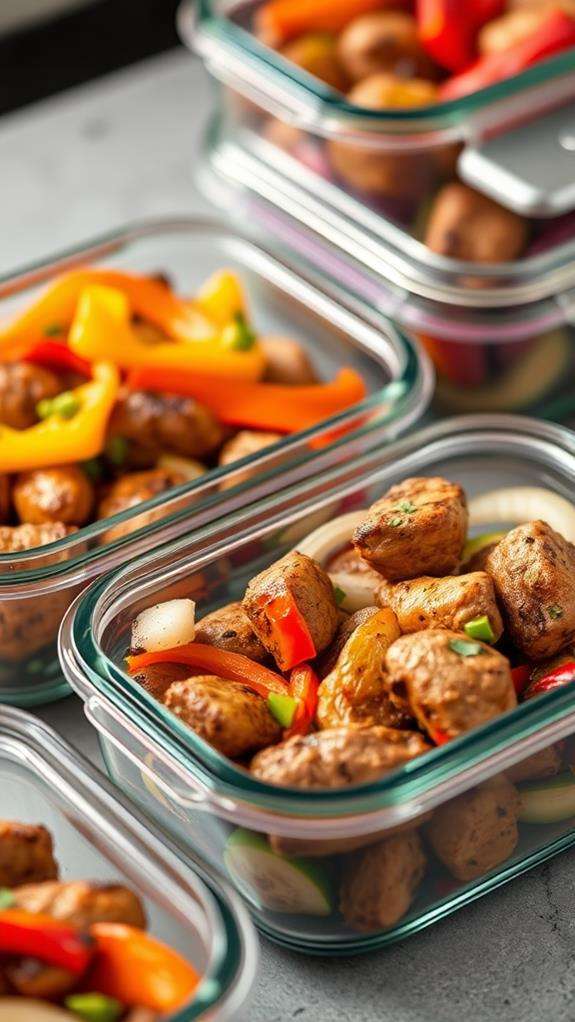
Proper storage of your leftover fajitas makes the difference between maintaining their delicious flavors and ending up with spoiled food. To maximize freshness, store your fajitas in airtight containers, keeping the meat and vegetables separate from the tortillas. Adding a little bit of water in a separate small container alongside your tortillas helps prevent them from drying out when reheating.
| Component | Storage Method | Duration |
|---|---|---|
| Meat & Veggies | Airtight Container | 3-4 Days |
| Tortillas | Sealed Bag | 1 Week |
| Combined Fajitas | Freezer Storage | 2-3 Months |
Don't forget to label your containers with storage dates to track freshness. If you're planning to keep your fajitas longer than 3-4 days, freezing is your best option. When you're ready to use frozen fajitas, always thaw them in the refrigerator rather than at room temperature to prevent bacterial growth. Your properly stored fajitas will maintain their quality and safety, ensuring you can enjoy them days after your initial meal. Remember to discard any leftovers showing signs of spoilage or those that have been refrigerated beyond four days.
Maintaining Flavor and Texture
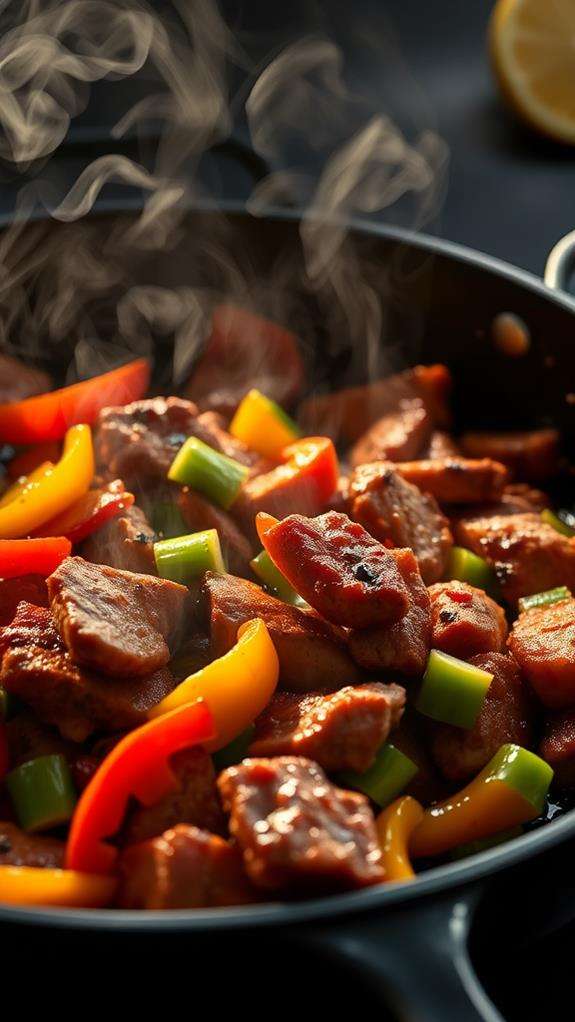
Successfully maintaining the flavor and texture of reheated fajitas requires a delicate balance of moisture control and heat management. When you're looking to enjoy your leftover chicken fajitas, you'll want to focus on preserving their original taste while preventing them from becoming dry or rubbery.
To guarantee your fajitas maintain their appealing qualities, consider these essential aspects:
- Add moisture-enhancing elements like lime juice or broth to revive the natural flavors
- Create a steam environment using aluminum foil or damp paper towels to lock in juices
- Monitor heating temperatures carefully to prevent overcooking and texture degradation
- Keep portions evenly distributed for consistent heating throughout
- Maintain proper timing based on your chosen reheating method
The key to success lies in choosing the right reheating technique for your situation. If you're working with a skillet, adding a splash of olive oil helps prevent sticking while maintaining moisture. For oven reheating, wrapping your fajitas in foil creates a protective moisture barrier. When using the microwave, you'll want to cover your fajitas and heat them in short intervals, checking frequently to prevent overcooking.
Quick Serving Ideas
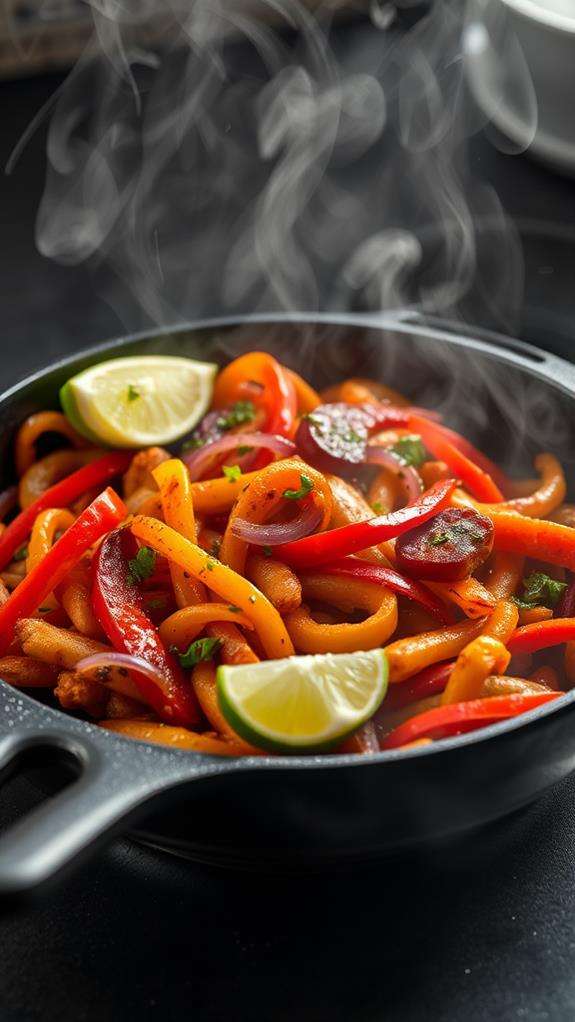
Transforming reheated fajitas into exciting new dishes opens up a world of quick serving possibilities. While you can always serve them straight from a hot skillet, using Souper Cubes for meal prep allows you to conveniently portion and store your leftovers before reheating. There are several creative ways to repurpose your leftovers that'll make them feel like an entirely new meal.
For a protein-packed breakfast option, you'll want to combine your fajita meat and vegetables with beaten eggs in a scramble. It's a simple way to start your day with a satisfying meal that takes minimal preparation. If you're looking for a casual snack or appetizer, transform your fajitas into loaded nachos by spreading tortilla chips on a baking sheet and topping them with your reheated fajita mixture and melted cheese.
You can also create convenient lunch options by rolling the fajita filling into fresh tortillas for wraps, or by adding the meat to a bed of crisp greens for a hearty salad. Don't forget to enhance any of these variations with fresh toppings like sour cream, zesty salsa, or creamy guacamole to add brightness and texture to your repurposed meal.
Frequently Asked Questions
How Do You Reheat Leftover Fajitas?
You've got several effective options to reheat your leftover fajitas. For the best results, use a skillet over medium heat with a touch of oil, flipping occasionally until warm. If you're short on time, wrap them in foil and heat in a 300°F oven for 10-15 minutes. For convenience, you can microwave them covered with a damp paper towel in 30-second intervals. An air fryer at 350°F works great too, taking just 3-5 minutes.
How Long to Heat up Fajitas in the Oven?
Did you know that 78% of reheated fajitas lose their ideal texture due to incorrect heating times? To properly heat your fajitas, preheat your oven to 300°F and wrap them in aluminum foil. You'll need 10-15 minutes for a small portion, but a full pan requires up to an hour. If you're heating multiple servings, spread them across several pans for even heating. For extra crispiness, you can finish with a quick blast at 350°F.
Can You Eat Fajitas the Next Day?
Yes, you can safely eat fajitas the next day if you've stored them properly in an airtight container in your refrigerator. They'll stay good for 3-4 days, but you'll want to reheat them to 165°F before eating. While the texture might be slightly different from fresh fajitas, they're still tasty and safe to consume. You can even get creative and transform your leftover fajitas into breakfast scrambles or top your nachos with them.
How to Warm up Leftover Mexican Food?
You've got several reliable methods to warm up your leftover Mexican food. For best results, wrap your dish in foil and heat it in the oven at 300°F for 10-15 minutes. If you're short on time, cover the food with a damp paper towel and microwave in 30-second intervals. For stovetop reheating, use a skillet on medium heat with a splash of water or broth to maintain moisture. Don't forget to heat until it reaches 165°F.





